SLLS259J November 1996 – October 2016 SN75LVDS82
PRODUCTION DATA.
- 1 Features
- 2 Applications
- 3 Description
- 4 Revision History
- 5 Description (continued)
- 6 Pin Configuration and Functions
- 7 Specifications
- 8 Parameter Measurement Information
- 9 Detailed Description
- 10Application and Implementation
- 11Power Supply Recommendations
- 12Layout
- 13Device and Documentation Support
- 14Mechanical, Packaging, and Orderable Information
7 Specifications
7.1 Absolute Maximum Ratings(1)
over operating free-air temperature range (unless otherwise noted)| MIN | MAX | UNIT | |||
|---|---|---|---|---|---|
| VCC | Supply voltage(2) | –0.5 | 4 | V | |
| VO | Output voltage (Dxx terminals) | –0.5 | VCC + 0.5 | V | |
| VI | Input voltage | Any terminal except SHTDN | –0.5 | VCC + 0.5 | V |
| SHTDN | –0.5 | 5.5 | V | ||
| Continuous total power dissipation | See Thermal Information | ||||
| TA | Operating temperature | 0 | 70 | °C | |
| Tstg | Storage temperature | –65 | 150 | °C | |
(1) Stresses beyond those listed under Absolute Maximum Ratings may cause permanent damage to the device. These are stress ratings only, and functional operation of the device at these or any other conditions beyond those indicated under Recommended Operating Conditions is not implied. Exposure to absolute-maximum-rated conditions for extended periods may affect device reliability.
(2) All voltage values are with respect to GND, unless otherwise noted.
7.2 ESD Ratings
| VALUE | UNIT | |||
|---|---|---|---|---|
| V(ESD) | Electrostatic discharge | Human-body model (HBM), per ANSI/ESDA/JEDEC JS-001(1) | ±4000 | V |
| Charged-device model (CDM), per JEDEC specification JESD22-C101(2) | ±500 | |||
(1) JEDEC document JEP155 states that 500-V HBM allows safe manufacturing with a standard ESD control process.
(2) JEDEC document JEP157 states that 250-V CDM allows safe manufacturing with a standard ESD control process.
7.3 Recommended Operating Conditions
| MIN | NOM | MAX | UNIT | ||
|---|---|---|---|---|---|
| VCC | Supply voltage | 3 | 3.3 | 3.6 | V |
| VIH | High-level input voltage (SHTDN) | 2 | V | ||
| VIL | Low-level input voltage (SHTDN) | 0.8 | V | ||
| |VID| | Differential input voltage | 0.1 | 0.6 | V | |
| VIC | Common-mode input voltage (see Figure 11 and Figure 7) |  |
2.4 -  |
V | |
| VCC – 0.8 | |||||
| TA | Operating free-air temperature | 0 | 70 | °C |
7.4 Thermal Information
| THERMAL METRIC(1) | SN75LVDS82 | UNIT | |
|---|---|---|---|
| DGG (TSSOP) | |||
| 56 PINS | |||
| RθJA | Junction-to-ambient thermal resistance | 57.3 | °C/W |
| RθJC(top) | Junction-to-case (top) thermal resistance | 14.6 | °C/W |
| RθJB | Junction-to-board thermal resistance | 26.2 | °C/W |
| ψJT | Junction-to-top characterization parameter | 0.5 | °C/W |
| ψJB | Junction-to-board characterization parameter | 25.9 | °C/W |
| RθJC(bot) | Junction-to-case (bottom) thermal resistance | n/a | °C/W |
(1) For more information about traditional and new thermal metrics, see the Semiconductor and IC Package Thermal Metrics application report.
7.5 Electrical Characteristics
over recommended operating conditions (unless otherwise noted)| PARAMETER | TEST CONDITIONS | MIN | TYP(1) | MAX | UNIT | |
|---|---|---|---|---|---|---|
| VIT+ | Positive-going differential input threshold voltage | 100 | mV | |||
| VIT– | Negative-going differential input threshold voltage(2) | –100 | mV | |||
| VOH | High-level output voltage | IOH = –4 mA | 2.4 | V | ||
| VOL | Low-level output voltage | IOL = 4 mA | 0.4 | V | ||
| ICC | Quiescent current (average) | Disabled, All inputs open | 280 | μA | ||
| Enabled, AnP = 1 V, AnM = 1.4 V, tc = 15.38 ns |
60 | 74 | mA | |||
| Enabled, CL = 8 pF, Grayscale pattern (see Figure 13), tc = 15.38 ns |
74 | |||||
| Enabled, CL = 8 pF, Worst-case pattern (see Figure 14), tc = 15.38 ns |
107 | |||||
| IIH | High-level input current (SHTDN) | VIH = VCC | ±20 | μA | ||
| IIL | Low-level input current (SHTDN) | VIL = 0 | ±20 | μA | ||
| IIN | Input current (LVDS input terminals A and CLKIN) | 0 ≤ VI ≤ 2.4 V | ±20 | μA | ||
| IOZ | High-impedance output current | VO = 0 or VCC | ±10 | μA | ||
(1) All typical values are at VCC = 3.3 V, TA = 25°C.
(2) The algebraic convention, in which the less-positive (more-negative) limit is designed minimum, is used in this data sheet for the negative-going input voltage threshold only.
7.6 Timing Requirements
| MIN | MAX | UNIT | ||
|---|---|---|---|---|
| tc | Cycle time, input clock(1) | 14.7 | 32.3 | ns |
| tsu1 | Setup time, input (see Figure 2) | 600 | ps | |
| th1 | Hold time, input (see Figure 2) | 600 | ps | |
(1) Parameter tc is defined as the mean duration of a minimum of 32000 clock cycles.
7.7 Switching Characteristics
over recommended operating conditions (unless otherwise noted)| PARAMETER | TEST CONDITIONS | MIN | TYP(1) | MAX | UNIT | |
|---|---|---|---|---|---|---|
| tsu2 | Setup time, D0–D27 valid to CLKOUT↓ | CL = 8 pF, See Figure 1 | 5 | ns | ||
| th2 | Hold time, CLKOUT↓ to D0–D27 valid | CL = 8 pF, See Figure 1 | 5 | ns | ||
| tRSKM | Receiver input skew margin(2)(see Figure 2) | tc = 15.38 ns (± 0.2%), |Input clock jitter| < 50 ps(3) |
490 | ps | ||
| td | Delay time, CLKIN↑ to CLKOUT↓ (see Figure 2) | tc = 15.38 ns (± 0.2%), CL = 8 pF | 3.7 | ns | ||
| Δtc(o) | Cycle time, change in output clock period(4) | tc = 15.38 + 0.75 sin (2π500E3t) ± 0.05 ns, See Figure 15 |
±80 | ps | ||
| tc = 15.38 + 0.75 sin (2π3E6t) ± 0.05 ns, See Figure 15 |
±300 | |||||
| ten | Enable time, SHTDN↑ to Dn valid | See Figure 3 | 1 | ms | ||
| tdis | Disable time, SHTDN↓ to off state | See Figure 4 | 400 | ns | ||
| tt | Transition time, output (10% to 90% tr or tf) | CL = 8 pF | 3 | ns | ||
| tw | Pulse duration, output clock | 0.43 tc | ns | |||
(1) All typical values are at VCC = 3.3 V, TA = 25°C.
(2) The parameter t(RSKM) is the timing margin available to the transmitter and interconnection skews and clock jitter. It is defined by
tc/14 – tsu1/th1.
tc/14 – tsu1/th1.
(3) |Input clock jitter| is the magnitude of the change in input clock period.
(4) Δtc(o) is the change in the output clock period from one cycle to the next cycle observed over 15000 cycles.
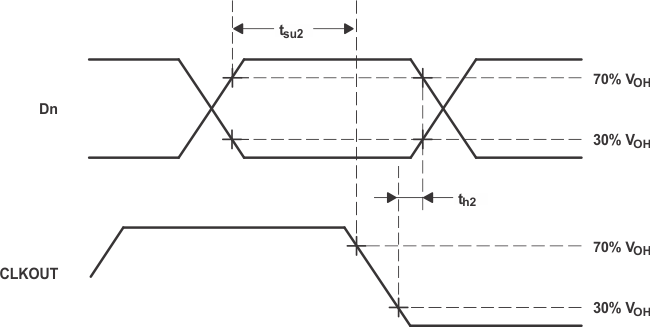 Figure 1. Setup and Hold Time Waveforms
Figure 1. Setup and Hold Time Waveforms
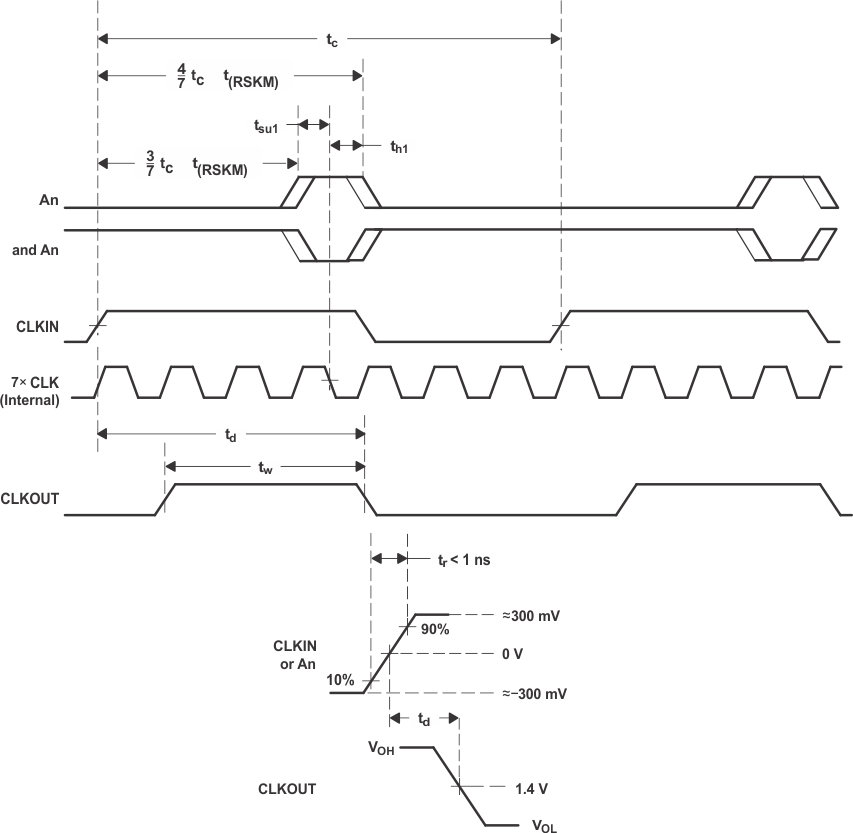 Figure 2. Receiver Input Skew Margin and Delay Timing Waveforms
Figure 2. Receiver Input Skew Margin and Delay Timing Waveforms
 Figure 3. Enable Time Waveforms
Figure 3. Enable Time Waveforms
 Figure 4. Disable Time Waveforms
Figure 4. Disable Time Waveforms
7.8 Typical Characteristics
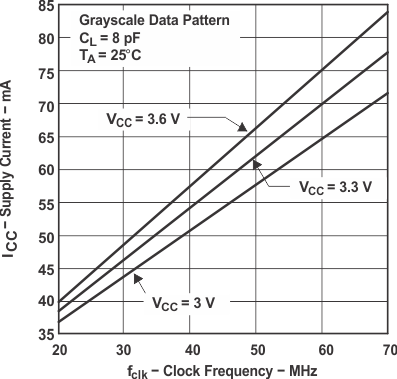 Figure 5. Supply Current vs Clock Frequency
Figure 5. Supply Current vs Clock Frequency
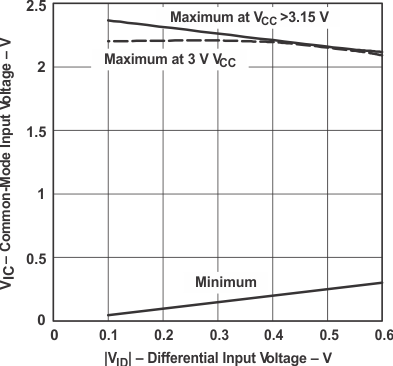 Figure 7. Common-Mode Input Voltage vs Differential Input Voltage
Figure 7. Common-Mode Input Voltage vs Differential Input Voltage
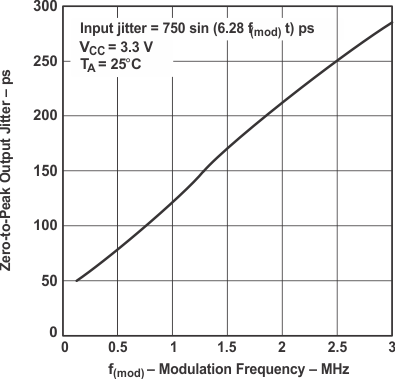 Figure 6. Zero-to-Peak Output Jitter vs Modulation Frequency
Figure 6. Zero-to-Peak Output Jitter vs Modulation Frequency